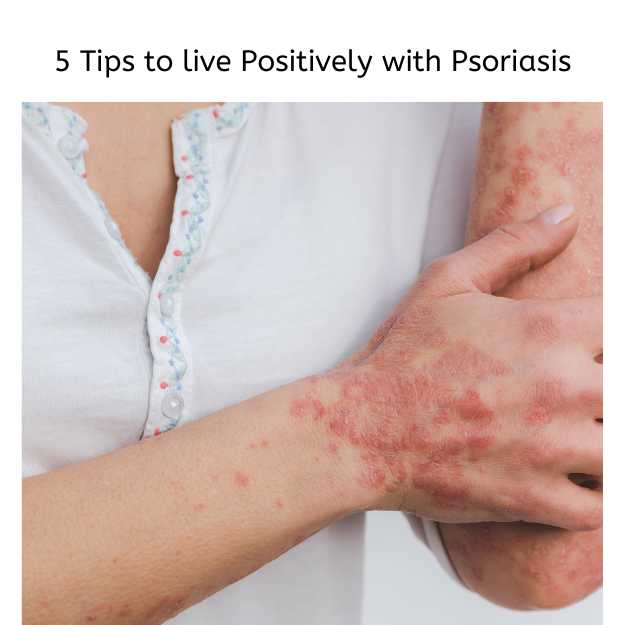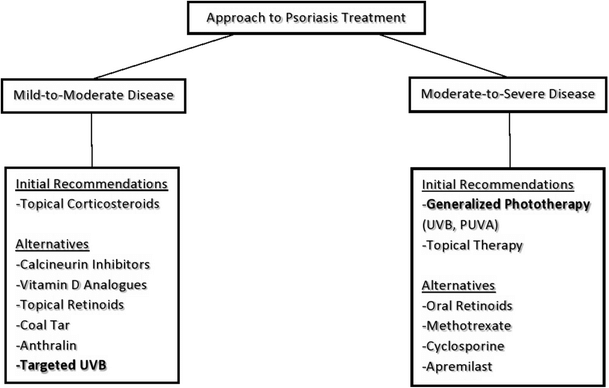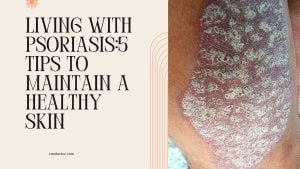
Image Source: raodoctor.com
Introduction
Last month, I published an article on 5 common Skin Diseases– one of them was Psoriasis. If you have not read it so far, you can do so here-
Psoriasis is a chronic skin condition that can be challenging to live with. Symptoms can be itchy, flaky, and irritating. It appears as itchy or sore patches and can also be ugly and sometimes even embarrassing.
Listen to this article
You can listen to this article while you are reading by clicking the button below-
In my day-to-day clinical practice, I get patients who are undergoing a lot of stress, due to multiple factors. Stress is one factor that triggers an attack of psoriasis.
That’s why it’s important to stay positive when living with psoriasis. It’s one of the biggest challenges of dealing with this skin condition, but there are so many things you can do to help manage psoriasis and stay positive at the same time. Here are five tips for living with psoriasis and staying positive:
What exactly is psoriasis?
Psoriasis is a disorder where the body produces too many skin cells as an autoimmune response [overactive immune system] to some trigger [we’ll learn about them below]. These skin cells grow abnormally and are shed more quickly than normal skin cells [have look at the picture on your right].

The skin cells build up and form scales and plaques [patches of abnormal cells] on the skin. These plaques or scales can appear on any part of the body, including the palms of your hands and soles of your feet. You will learn more about this when we discuss the different types of psoriasis.
And since psoriasis can appear on any part of your body and can look different from person to person, it’s important to learn what it is and what it looks like.
Psoriasis can also appear on your nails, so it’s important to keep them trimmed and healthy, too.

It’s also a good idea to wear UV-blocking clothing and apply sunscreen regularly, even when psoriasis isn’t affecting your skin and you are prone to flare-ups. This will help prevent future outbreaks.
What are the various causes of Psoriasis?
As discussed above, psoriasis is a chronic autoimmune disease that affects the skin.
The exact cause of psoriasis is not yet known, but several factors are believed to contribute to the development of the disease. The following psoriasis causes are known to trigger this skin disease-
- Genetics: Psoriasis is known to run in families, and researchers have identified several genes that are associated with the disease.
- Immune system dysfunction: Psoriasis is thought to be caused by an abnormal immune response that leads to inflammation and the overproduction of skin cells.
- Environmental factors: Certain environmental triggers can exacerbate psoriasis symptoms, including stress, injury to the skin, infections, and medications.
- Lifestyle factors: Smoking, alcohol consumption, obesity, and poor diet have also been linked to an increased risk of developing psoriasis.
Examples of environmental triggers include streptococcal infection, injury to the skin, and certain medications like lithium, beta-blockers, and antimalarials.
Lifestyle factors like obesity and smoking can also worsen psoriasis symptoms and make the disease more difficult to manage.
What are the different types of psoriasis that are encountered frequently?
There are many types of psoriasis. Describing each is beyond the scope of this article. However, I have included a brief yet salient features of all these types here.
The different types of psoriasis frequently encountered include [see picture of its presentation below]:

- Plaque Psoriasis-This is also known as psoriasis vulgaris and is the most common type of psoriasis, accounting for about 80% to 90% of cases. It causes raised, red patches covered with silvery white scales, which can be itchy and painful. They occur symmetrically on both sides of the body, for e.g., on knuckles of both hands or on the elbows or on the knees [see the pictures below].
- Guttate psoriasis: This type, also known as psoriasis guttate, usually starts in childhood or early adulthood and is characterized by small, pink or red spots on the skin. It is often triggered by a bacterial infection, such as strep throat.
- Inverse psoriasis: This type of psoriasis occurs in skin folds, such as the armpits, groin, and under the breasts. It is characterized by smooth, red patches of skin that may be sore or itchy.
- Pustular psoriasis: This type of psoriasis is characterized by white blisters filled with pus surrounded by red, inflamed skin. It can occur anywhere on the body but is most commonly found on the hands and feet.
- Erythrodermic psoriasis: This is the least common type of psoriasis and is characterized by a widespread redness of the skin, often accompanied by severe itching and pain.



Useful Resource- Types of psoriasis
These are the psoriasis commonly found affecting the skin. Apart from these, other types are-
• Nail psoriasis – causing changes in the nails such as pitting, thickening, and discoloration.
• Scalp psoriasis -psoriasis scalp causing red, scaly, and flaky patches on the scalp, often mistaken for dandruff.
• Psoriatic arthritis – a type of psoriasis that affects the joints, causing pain, stiffness, and swelling.
Psoriasis treatment options depend on the severity of your condition. You may not need any treatment at all if you have mild psoriasis that isn’t causing any problems.
But if your psoriasis is moderate to severe, you may need medication and/or topical treatments. Here’ how to manage this disease.
Talk to your doctor about treatment options for psoriasis
If you’re living with psoriasis, it’s a good idea to talk to your doctor about treatment options. This will help you address any concerns you have with the condition and find ways to manage it.
Practice self-care in psoriasis
Whether you have mild or severe psoriasis, it’s important to practice self-care. Self-care can help you manage your psoriasis and stay positive. So what does psoriasis self-care entail?
You can start by practicing good hygiene and wearing clean clothes. It’s also a good idea to avoid people who are sick to prevent further infection and transmission. You can also use medicated creams and ointments to reduce psoriasis scales, itching, and irritation.
And you can use moisturizers to help manage dry skin. You can also do yoga, mindfulness meditation, and other activities that help reduce stress and anxiety.
Set small and attainable goals
Living with psoriasis can be challenging. There will be days when you feel like you’ve hit a wall, and there’s nothing you can do to move forward.
That’s when setting small and attainable goals can help. You can start by wearing clothes that cover up your psoriasis. It’s also a good idea to avoid going in the sun, especially if you’re experiencing an outbreak.
You can also set goals to stay positive by surrounding yourself with people who love and accept you, regardless of your skin condition. It’s also a good idea to join a support group where you can talk to others who are living with psoriasis.
Surround yourself with positive people
It’s important to surround yourself with positive people when living with psoriasis. However, this will seem harder than you think.
People who respond negatively when you tell them about your psoriasis can be damaging to your self-esteem. So, surround yourself with people who are accepting of your condition and don’t judge you for it.
You deserve to be loved and accepted for who you are, regardless of your skin condition. If you find that you’re surrounded by people who are unsupportive, it may be time to make a change – avoid them!
You can start by joining a support group where you can talk to others who are living with psoriasis. You can also talk to your doctor about finding a therapist who specializes in treating patients with psoriasis.
Exercise regularly
Exercising regularly can help reduce stress and anxiety, which are common symptoms of psoriasis. It can also be a great way to relieve pain, boost your mood, and improve your sleep. You can start by taking a daily walk or doing yoga at home.
And if you feel comfortable enough, you can also join a gym or sports team. You can practice many sports while living with psoriasis, including tennis, basketball, swimming, and more.
Your doctor may recommend certain sports over others to help relieve any pain or discomfort while also helping you stay positive.
Psoriasis treatment
There are many treatment options available for psoriasis. This is because psoriasis can occur in many different forms, which makes it challenging to find a specific treatment. Here is a graphic presentation of treatment for this condition-

Psoriasis can range in severity and symptoms, so treatment differs depending on each person’s condition. Topical treatments are creams and ointments that you apply directly to the rash to help soothe irritation and itching.
Systemic medications are oral drugs that you take daily to help slow or even stop the immune system from producing too many skin cells.
And phototherapy is a treatment where you sit under a special light to help clear up and heal psoriasis.
Photo therapy for psoriasis
Phototherapy, commonly known as “light therapy,” is a treatment that uses ultraviolet light to clear up psoriasis and other skin conditions.
There are two types of light that are used in phototherapy: broadband UVB (UVB) light and narrowband UVB (NB UVB).
UVB light therapy is the most common treatment for psoriasis, especially psoriasis that covers a large area of the body, such as the hands or the knees.
UVB light therapy is a safe and effective treatment for psoriasis. In fact, it’s often the first treatment that doctors recommend for people who have psoriasis.
Drugs used in psoriasis
When psoriasis is moderate to severe, doctors may prescribe oral medications. These oral medications can help reduce symptoms and clear up psoriasis faster than topical treatments.
In addition to reducing symptoms, these oral medications can also slow the rate at which the immune system produces skin cells.
This can help reduce the frequency and severity of future outbreaks. Topical treatments can be helpful for mild psoriasis and might be all you need to manage your condition.
But if you have moderate to severe psoriasis, oral medications may be necessary to clear up your symptoms. If you’re currently taking oral medications for psoriasis and want to get pregnant, talk to your doctor about switching to another treatment.
Useful Resources
Conclusion
Psoriasis is a challenging skin condition to live with, but it doesn’t have to be a completely negative experience.
By following these 5 tips for living with psoriasis and staying positive, you can better manage your condition and live a happier, healthier life!
It’s important to remember that you’re not alone. Millions of people have psoriasis, so there’s a good chance that you know at least one of them!
With the right support system, you can learn to better manage your condition and live your best life despite psoriasis.
Final words-
I hope you have learned a lot about this skin condition. I will be highly obliged if you could share this article on various social media icons available at the bottom. Alternately, you can click to Tweet-
Living with Psoriasis:5 Tips to maintain a healthy skin Share on X
